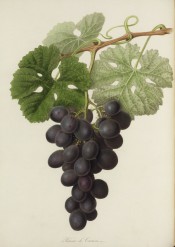Vitis vinifera ‘Raisin de Carmes’
Probably Raisin de Carmes. ‘Bunches long, loose. Berries very large, of an irregular oval figure, with a few small berries intermixed. Skin rather thick, of a dusky reddish purple colour, and covered with a fine bloom. Flesh firm, juicy, and very rich, combined with a little acid. Seeds large, seldom more than one in each berry.’ [George Lindley – Orchard Guide p.203/1831].
Horticultural & Botanical History
‘The variety of Grape here figured [‘Raisin de Carmes’], may have received some other appellation than the one now given, which does not occur in any catalogue, though the vine has been long cultivated in some of our gardens; and it is highly probable that its conspicuous appearance, and good qualities, must have procured it the attention of the cultivator. For specimens of the fruit, Mr. Hooker is indebted to J. R. Wheeler, Esq. of Gloucester Place, New Road; who received the plant from George Jenner, Esq. of Chiselhurst, about seven years ago. The wood is rather slender, of a yellowish brown, striated with a deeper colour, but not red, like the wood of most coloured Grapes; the distance between the joints very short. Leaves seldom more than 6 inches in length, and about 1/5th less in breadth; deeply divided onto five nearly equal, roundish lobes; the lower one long in mature leaves; serratures rather broad, but not deep; the under surface rough, with small dots; nerves pubescent; petioles shorter than the leaves, pale green. Buds full, mostly triple. Fruit in rather loose long bunches, very large, with a few small berries interspersed; of an irregular oval form. Skin rather thick, of a dusky, reddish purple colour, covered with a fine meal. Flesh somewhat firm, extremely rich, though containing a considerable portion of acid. Seeds large, seldom more than one in each Grape. The filaments and anthers frequently remaining when the fruit is quite ripe. The vine grows freely, and bears well; but we learn from Mr. Wheeler’s gardener, Mr. Thomas Carel, that it requires a good heat, and great attention must be paid to it at the time of flowering. It is recommended to those cultivators who can give it a place in the stove. Since this was written, this Grape has appeared under the name of Raisin de Cabo. With what propriety this name is given, cannot at present be ascertained.’ [PL vol.1, pl.10/1818].
Also figured in Pomona Britannica [PB pl.XLVII/1812].
History at Camden Park
Listed in all published catalogues as ‘Raisin des Dames’ [Vines for Table Only no.11/1843].
Notes
Published Jun 23, 2010 - 03:12 PM | Last updated Jul 21, 2011 - 12:38 PM
| Family | Vitaceae |
|---|---|
| Category | |
| Region of origin | Garden origin, unknown |
| Synonyms |
|
| Common Name | Grape, Table Grape |
| Name in the Camden Park Record |
Raisin des Dames
|
| Confidence level | high |


